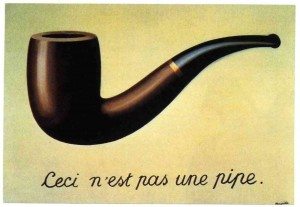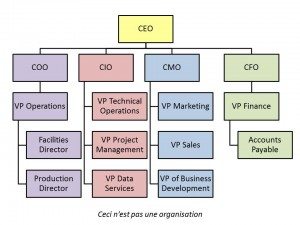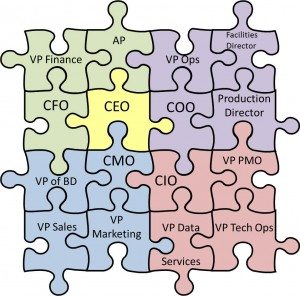 “The famous pipe. How people reproached me for it! And yet, could you stuff my pipe? No, it’s just a representation, is it not? So if I had written on my picture “This is a pipe”, I’d have been lying!” – Rene Magritte
“The famous pipe. How people reproached me for it! And yet, could you stuff my pipe? No, it’s just a representation, is it not? So if I had written on my picture “This is a pipe”, I’d have been lying!” – Rene Magritte
====
Take a look at this organization chart. Chances are your company has one that looks somewhat similar – a graphical representation of your company, the reporting relationships and the responsibilities of each group within the overall team. Pretty straightforward stuff that can be a very useful tool in certain instances.
But as Rene Magritte’s famous painting “The Treachery of Images” points out, images can be tricky. Sometimes when we create an image of what something looks like, we mistake the image for the actual and cloud the true picture of what we’re trying to communicate. This can become especially problematic when a company or organization begins to look for talent to supplement or replace members of their team. Too often, it becomes about replacing a position on an organization chart and literally “filling a square”, looking at the open role as part of a top down hierarchical structure rather than what it is – a group of human beings working towards a goal that requires a new/different human being to join them. The Org Chart mentality greatly limits both the scope of potential talent who might move the organization forward as well as limiting where the organization can expand its capabilities. Companies that speak in earnest of breaking down silos are sometimes unaware of how much those stereotypical silos are reinforced through visualizing their organization by way of a conventional organization chart.
It’s obvious that people aren’t perfect boxes and that they don’t fit into perfect boxes. Additionally, their interactions aren’t solely within their own department/group but range across the entire organization. People are squiggly and wiggly and they have strengths and weaknesses, proficiencies and learning curves. People are, in short, distinctly non-linear. So displaying their relationships in a linear fashion is counterproductive. So what if we looked at it in a different way? What if we started looking at our companies and organizations more like this?
Now please keep in mind that this is a conceptual exercise. I’m certainly not advocating changing your company’s organization chart to look like a jigsaw puzzle (in larger multinational corporations, locating someone’s direct dial extension could take the greater part of a day). The focus here is on changing the concept of how you look at your organization when it comes to organizational dynamics and talent management / acquisition. Rather than looking at the organization from top down silos, this graphical representation shows the organization as an interconnected unit.
The conceptual jigsaw rendering implies the interdependence of teams and the individuals within those teams as well as the varying strengths and weaknesses between team members. If you begin to visualize your company as an interconnected unit, you’re apt to look at potential team members in a more effective way other than the traditional method of matching bullet points on resumes and job descriptions.
For example, let’s say the organization above needs to find a new Vice President of Marketing. In looking at this graphic we can see that the VP Marketing role is connected to Sales, Business Development and the CMO/Head of Brand, which we would normally conclude from looking at a conventional organization chart. But as depicted in the previous illustration a conventional org chart tacitly implies a hierarchical relationship between these positions (with VP Marketing appearing “above” VP of Sales for example), this representation places them on a more even, interdependent level.
There’s also an implication of strengths and weaknesses between the performers. Naturally this strength/weakness balance will vary from company to company and person to person, but as conceptually depicted we can see that this particular VP of Marketing has strong influence over the success of the VP of Sales; perhaps they had a previous background in Sales which aided their marketing proficiency or the VP of Sales was more junior and benefited from the VP of Marketing’s sagacity. Whatever the implied reason, when the team interviews a new potential VP of Marketing, they will now take into account not just the position/experience/job requirements, but the interactions/relationships between the individual people who play these roles within the organization. It’s not just about filling the VP of Marketing role; it’s about finding an individual who fits the entire, interdependent puzzle. What’s important here is gaining an understanding of the dynamics between the performers and the subsequent realization that over the course of time, the strengths and weaknesses of all of these performers will ebb and flow.
Another advantage to the conceptual depiction is the implication that those strengths/weaknesses/interdependencies cross lines between departments and sections of the organization. Here, the VP of Marketing is also closely connected with the VP of Data Services, implying the link between Data and Marketing as well as a touch point with the Chief Information Officer; connections that are conspicuously absent and difficult to illustrate using a traditional Org Chart. In truth we could connect any section of the organization  to another as they are all interdependent on some level. You could in fact expand the jigsaw even further by adding external vendors/service providers that work with the organization. The purpose of this model is to show the interconnections in a non-traditional way.
to another as they are all interdependent on some level. You could in fact expand the jigsaw even further by adding external vendors/service providers that work with the organization. The purpose of this model is to show the interconnections in a non-traditional way.
Looking at your organization from the inside out
Taking this concept further, beyond positions and interdependencies and towards culture and values we begin to see a more complete picture of the organization. In this graphic, we can see the organization and small subset of the relationships depicted in 3 dimensions.
[Please bear in mind that I’m aware of the irony that we’re back to displaying team members as “boxes”. While I flatter myself that I have some insight into talent acquisition and organizational structure, the concept is somewhat difficult to illustrate and I am not a graphic artist (dozens of graphic artists just nodded their heads in agreement). Ideally this would be illustrated using 3d jigsaw pieces carried over from the previous illustration.]
Hopefully what is being communicated is this – the culture, attitude and ethos of an organization do not flow from the top down but rather from the inside out. At the core of any organization is the leadership team/founder(s) whose philosophy and character will ultimately guide the organization. That obviously has to do with goals and mission but also to cultural content as well. Looking at the organization in 3 dimensions suggests that each member is part of a whole and that each part is important. Lose a “piece” of the puzzle, and the organization has changed. And when strong culture flows from the core of an organization, team members feel valued and value their place in the organization as well.
Employer Brand has been a concept that we’ve been speaking about for years. And while some organizations have embraced the idea that they must offer an attractive opportunity and culture to acquire the best talent, others seem to confuse trappings and extras with true culture, advertising their culture as a draw without really understanding what “culture” actually means. Claiming that your team members “work hard and play hard” and bragging about amenities they believe will attract potential talent may look good in a job posting. But in the end your company culture is not defined by a ping pong table and Taco Tuesdays. Your company culture is defined by how you treat your team members, whether their ideas are heard and heeded and whether they are recognized for their contributions and aided in their professional growth. And that culture is defined from the inside out. If that core culture is not present, then all the amenities and “Scooby Snacks” in the world will not help you assemble a winning team.
Putting it all together – for Employer and Talent
So how do we use this information in practical, real world sense? As an employer, how do you find talent that fits the puzzle? And as a talent, how do you find an organization with the right culture? Here are some short, practical examples.
For the Employer
When you’re looking over the qualifications of a potential new team member, naturally you will take into account their experience and abilities as it pertains to your open position. Once you’ve found a strong candidate, take a deeper look at their career path. Did the last place they worked have a similar culture to yours? If you’re a smaller organization, having that attractive Fortune 500 talent interested in your role might seem ideal. But will they be able to work effectively within your organization, especially if there is a more “hands on” aspect to your role that may not have been present in their previous company? And take the 3-dimensional approach to your organization. How did the previous individual in the role interact personally within the team, i.e. were they a sagacious, steady leader who balanced out a group of energetic doers, or vice versa? Adding another dynamic personality to an already kinetic group may be the worst thing you could do – or the best thing. The key here is to look beyond bullet points of a job description / resume and look at the potential talent as a human being and how they balance out the entire organization.
For the Talent
Just as your potential new employer will be taking a thorough look at you, you should be doing the same of them. A strong, positive culture will permeate throughout a company, through all levels of the organization. How are your initial interactions with the administrative assistant/receptionist? Do they seem knowledgeable and personable? That’s a positive sign. How are your interactions with the team members during the course of the interview process? Ask them about leadership team and whether they feel the company has a culture of growth and innovation. If you’re getting mixed messages (or worse, strongly negative messages) you might want to consider whether this is the right organization for you. And while you may feel that the hiring manager is a great person from whom you could learn and grow, do some research on the CEO/Leadership Team/Founders. If the high level leadership seems to be lacking in ethics or is not fostering a culture of respect, you need to be aware of it. Your direct supervisor might be a dream boss but if the CEO is a challenge, you need to take that into consideration; your hiring manager is more likely to leave/be replaced than the CEO.
Conclusion
Any organization is more than just its picture, its logo or its org chart. It is made up of a group of living, vibrant, three dimensional individuals working towards a common goal/success. Those individuals bring with them more than just a set of skills and responsibilities; they bring with them personalities and styles that make them well suited in certain areas and in need of guidance in others. But when working together in harmony, an organization with a strong, positive culture with team members who play to each other’s strengths can accomplish almost anything. When you begin to look at your organization in a holistic manner, with strengths and weaknesses, interdependencies and interconnections, you’ll gain a much stronger understanding of how each individual team member contributes to the organization’s overall success and be able to bring in new talent who will move the organization ahead towards continued and future achievement.
C’est une organisation vraiment efficace

